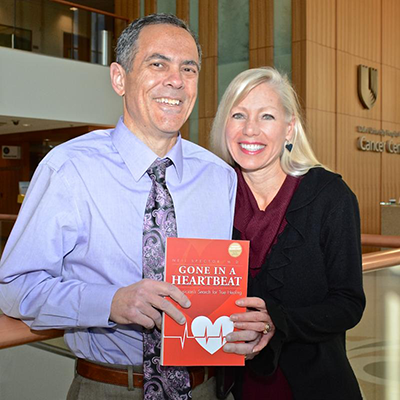
For many years, the late Neil L. Spector, MD, who was a leading cancer researcher at Duke Cancer Institute, struggled with Lyme disease. Initially, he was misdiagnosed and when finally treated with antibiotics, some of his symptoms improved but his heart was irreparably damaged due to Lyme carditis, a condition that occurs when Lyme disease bacteria enter the tissues of the heart.
In 2009, after suffering near-fatal heart failure, Spector underwent a heart transplant. He passed away on June 2020 from a clinically aggressive post-transplant lymphoproliferative disorder as a result of immunosuppressive drugs used to prevent heart rejection.
Recently, the Bay Area Lyme Foundation provided a grant of more than $2 million to support Lyme disease research at Duke in honor of Spector, who was the Sandra Coates Associate Professor in the Duke University Department of Medicine and also served on the Foundation’s scientific board. The grant will fund research that Spector started with Timothy Haystead, PhD, professor in the Department of Pharmacology and Cancer Biology, which aims to develop an effective treatment for Lyme disease.
“With an estimated 400,000 new cases diagnosed every year in the United States, Lyme disease is the most common tick-borne illness in the country,” says Haystead. “Despite early diagnosis and treatment, it has been reported that about 36% of individuals with the disease will experience persistent, chronic symptoms consistent with active infection.”
“I know his beautiful and bright spirit lives on through the incredible efforts of his colleagues who also share his vision to ultimately improve the lives of those suffering from these oftentimes debilitating diseases.”
In the mid-2010s, Spector initiated research into the tick-borne bacteria Borrelia burgdorferi, which causes Lyme disease in humans. His goal was to find alternatives to antibiotics, which are currently the only available treatment for Lyme disease, in hopes of helping patients who didn’t get better with antibiotics. Spector recruited Haystead to the project, and together they looked into potential treatments using drug discovery methods that were pioneered in Haystead’s lab and have proven successful in identifying treatments for cancer.

Haystead is working on developing both an effective treatment for the disease as well as a new diagnostic tool for it. One of the biggest challenges in Lyme disease, he says, is accurately diagnosing the infection in patients with chronic disease. When the disease is diagnosed late, antibiotics are not effective. “We developed novel small molecule inhibitors that target the Borrelia burgdorferi’s proteins and eliminate the bacteria by destroying its DNA,” Haystead says. By attaching fluorescent chemical compounds called fluorophores to these inhibitors, the scientists can also use them as a diagnostic tool to detect the presence of Lyme disease.
Haystead says this new treatment will require only one single dose to eliminate the bacteria instead of a three-to-four-week course of oral antibiotics. He predicts that the grant will allow him to start clinical trials in about two years, and he hopes that the work will be applicable to other parasitic diseases like malaria. The research is conducted in collaboration with researchers from Tulane Medical Center; University of California, Davis; and the University of North Carolina at Chapel Hill.
“Novel Research”

"We are honored to continue with Neil's ideas to further help people with persistent Lyme disease," says Linda Giampa, executive director of Bay Area Lyme Foundation. "Duke is conducting a novel research approach that no one else is doing. Taking a method that works in cancer and applying it to Lyme disease is currently one of the most forward-thinking projects we've come across. Bay Area Lyme has funded over 100 projects since its inception, which were either for a Lyme diagnostic or for a therapeutic, but not both."
The foundation started a grassroots campaign to raise some of the grant funds through its social media platforms and website. Over 150 people from around the world donated in Spector’s honor. “They donated between 25 and 5,000 dollars,” Giampa says. “It was so heartwarming and wonderful to see how many people loved him.” In addition, a regular donor to the foundation contributed significantly to the project and helped to bring the grant to over $2 million.
Beautiful and Bright Spirit
Spector’s widow, Denise Spector, PhD, is grateful for the foundation’s gift in his honor. “I was delighted to hear the tremendous news about the Bay Area Lyme Foundation’s funding to support the continuation of the important and compelling work that my beloved husband Neil, Dr. Tim Haystead, and their colleagues began,” she says. “My heart is filled with gratitude for the generous donors, many of whom have been personally affected by the devastating effects of chronic Lyme disease.”
Denise Spector says that Neil Spector was incredibly passionate about his research in the areas of tick-borne infections and cancer, and he worked tirelessly to help develop more sensitive diagnostics and effective therapies for these illnesses. “He was a true champion for the Lyme community and gave so much of himself to help others who were struggling with Lyme disease and co-infections,” she says.

The Bay Area Lyme Foundation gift is part of the Duke Science and Technology Initiative, which aims to elevate excellence in the sciences and foster transformational advances in fields that address the critical challenges facing the world today through faculty recruitment and retention.
March 5, 2021
By Aliza Inbari